|
Maritime Topics On Stamps :
Life on the Mississippi!
|
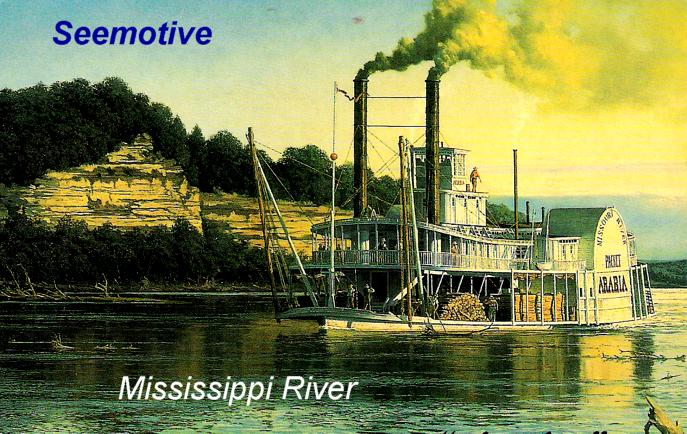
|
The name Mississippi, probably derives from the language of the Algonquian Indians.
It is composed of the words "messe" for "large" and "sepe" for "water".
Another possible origin would be from the language of the Ojibwa, which has a
special word, "Messipi" for "big river".
|

|
The Mississippi River is 3778 kilometers long, which puts it on third place among the
longest rivers of the earth.
It originates from Lake Itasca in northern Minnesota and flows about 160 kilometers south
of New Orleans in the Gulf of Mexico.
The Great River Road "(documentary on the left) is composed of many water ways that run
along the Mississippi through 10 U.S. states and 2 Canadian provinces.
|

|
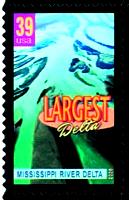
|
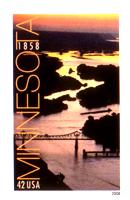
|
On its way south the Mississippi cuts through almost all of the US territory from
north to south.
It converges with the Missouri and the Ohio rivers.
The Americans call it the longest river system (see the stamp on the left hand side).
It forms a delta 28,600 square kilometers in size, which puts it among the largest
deltas worldwide. It has five main branches (stamp in the center).
The right hand stamp shoes the river's route through the state of Minnesota.
|
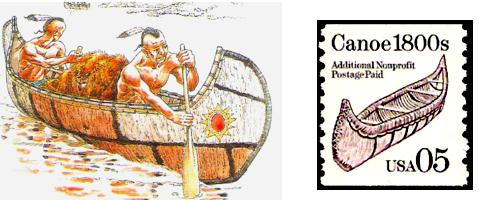
|
Like nothing else the Mississippi expresses the American Dream, the myth of the
United States: the struggle to become a new nation, conquering the continent,
the exploration of the wild west, the doom of the American Indians and the sufferings
of the slaves.
The first boats on the Mississippi were Indian canoes.
|
On the 8th of may in 1541, the first European to see the river was the Spanish explorer
Hernando de Soto. He named it Rio de Espiritu Santo (River of the Holy Spirit).
In 1683, one hundred and forty-two years later, René - Robert Cavelier, a French nobleman,
Sire de La Salle, arrived at the Mississippi delta, in the Gulf of Mexico, and claimed
all land along the river to become French property (stamp on the right hand side).
The new colony was named Louisiana, in honor of the French king Louis the fourteenth.
Again a long time thirty-five years passed, until a first settlement was founded, t
he city Nouvelle Orléans (New Orleans).
|
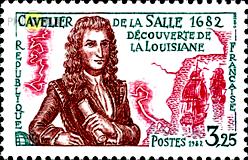
|
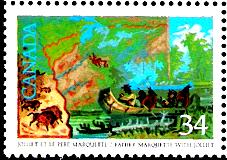
|
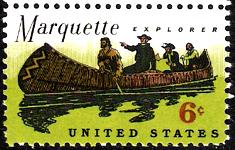
|
Another Frenchman, a priest and explorer was Jaques Marquette (1637 - 1675).
In 1673 he and the fur trader Louis Joliet set out to a major expedition at the
Canadian Saint Ignace. They hit the Mississippi, the Missouri and the Ohio.
They became to believe, that the river would flow into the Pacific Ocean.
After proceeding another 450 km down the Mississippi river, in the territory of Arcansas,
they decided to turn back, fearing to otherwise fall into the hands of the Spaniards.
|
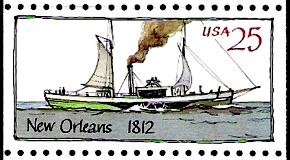
|
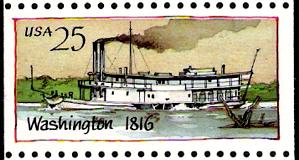
|
In 1812 the first of the famous paddle steamers, Robert Fulton's "New Orleans",
started its regular service between New Orleans and Natchez.
The boat's maximum speed was 5 miles per hour downstream, and 3 miles per hour upstream.
She measured 43 meters in length and 9 meters in width.
In 1816 the first steamer with two decks, the "Washington" tied up in New Orleans.
Her steam engine delivered 100 horse powers.
In 1817, only one year later,
there were already seventeen steam-powered vessels cruising on the Mississippi.
And in 1850 their number was up to seven hundred and forty.
|
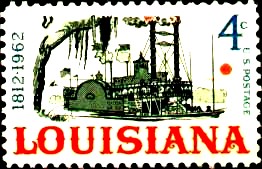
|
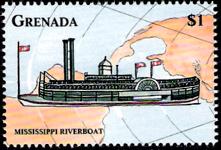
|
Most of the ships ran between New Orleans and Louisville, much less between
New Orleans and Natchez. Their main stay cargo was cotton, which they carried down
into New Orleans harbor, from where it was shipped to Europe.
|
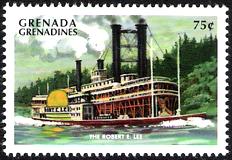
|
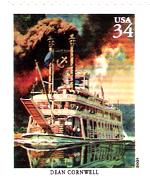
|
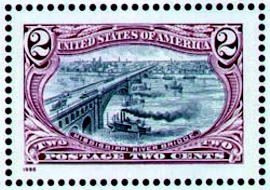
|
The majority of the steamers measured between 60 and 100 in length, 10 to 12 meters in
width. They had flat bottoms and no keel. The draft was 1.8 meters at most.
The height including one or two smoke stacks was about 17 meters and the water
displacement up to 2,700 tons.
The engines were light weight so-called "high pressure steam engines" with a vapor
pressure of 3 to10 bars. But the high pressure also caused frequent boiler explosions.
The engines were fueled with coal or wood.
The ships had 3 to 5 decks and 60 to 80 cabins.
The gangway was placed at the bow (see the stamp in the center).
The higher, bottom deck was designated for cargo (left hand stamp).
The other stamp on the right hand shows a scene of a paddle steamer in front of a
bridge at St. Louis.
|
|
The paddle wheel was quite often moved to the stern, to protect it from drifting beams,
and collisions. A typical paddle wheel was 8 to 9 meters wide,
8 meters in diameter and weighed 44 tons.
|
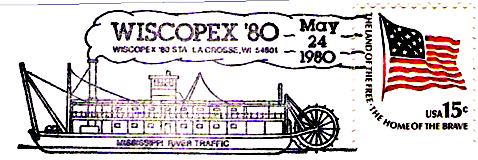
| |
River boats with side paddle wheels were faster than tail-wheelers, and were of course
much more manoeuvrable. The side wheels could run in opposite directions with respect
to each other too. This feature enabled them to turn on a spot.
|
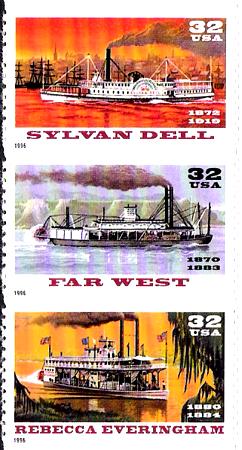
|
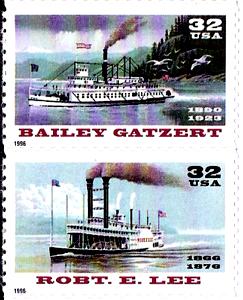
|
The stamps show 5 different paddle steamers, which took up service between 1866 and 1890.
Most widely known is the "Robert E. Lee", which was built in 1866 for 200.000 dollars
in New Albany, Indiana (on the stamp at bottom right). She could load 5.741 bales of
cotton.
Her cabins, dining room and lounges were luxuriously furnished. The boat with
two side wheels was quite fast. She became nicknamed "The Monarch of the Mississippi".
She was lost by fire in 1892 .
|
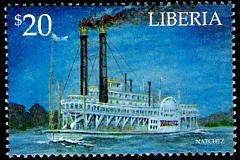
The "Natchez", built in 1869 on the Mississippi (left hand stamp) was number six of seven
river boats of the same name.
According to some other records she was seventh of nine
boats.
Some data of the famous ship:
Length 92 m, width 13m, side paddle wheels,
speed in service 10 knots, two funnels, four decks.
In 1870 the boat hit a record average speed of 11.7 knots on the 1.672 km long
route from New Orleans to St. Louis. This record was not topped for 25 years.
| |

|
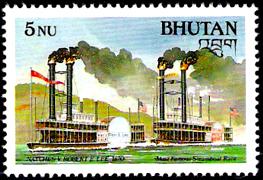
| Whenever an opportunity showed up, the Mississippi steamers would race
each other. "The Great Mississippi Steamboat Race" took place in July 1870 between the
"Robert. E. Lee" and the "Natchez VI" from New Orleans to St. Louis.
The "Robert E. Lee" won in 3 days, 8 hours and 14 minutes.
She carried however no load, made only one stop and did not stop in spite of fog.
|
The "Natchez" had cargo on board, stopped in other ports and tied up in fog overnight.
Even then she arrived in St. Louis only a little less than 3 hours later.
Obviously she was the true winner. There are several different accounts why the
"Robert E. Lee" did win.
|

|
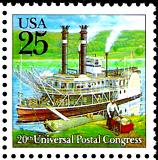
|
Of course, the mail service also used the Mississippi steamers.
It was the case in the 19th century, and is done even today on the replicas of the
legendary boats (above is the "Delta Queen").
|
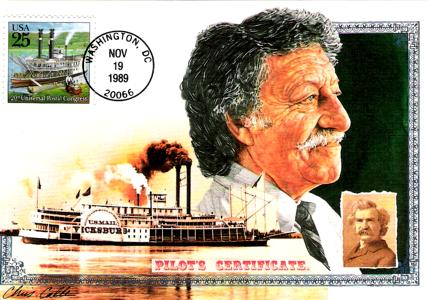
|
The American Samuel Langhorn Clemens lived from 1835 to 1910. Since 1861 he changed
his name to Mark Twain.
He was a journalist, reporter, social critic, moralist,
silver digger, travel writer and ship pilot.
He earned the pilot license on the Mississippi and sailed between New Orleans und
St. Louis for four years.
|
This by the way explains his nickname: Whenever the deck hand fathomed
the water depth and called out "mark twain" (second mark), then there was still
enough water under the keel.
Next to the children's books with its popular
characters Tom Sawyer and Huckleberry Finn, the book "Life on the Mississippi" is
rightfully placed among world seafaring literature.
|
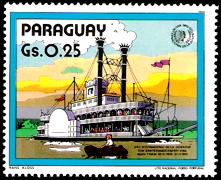
|
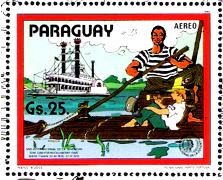
| |
In comparison to the then widely spread books on prigs and well behaving girls,
the stories of Tom Sawyer und Huckleberry Finn featured their exact contrary.
These guys did beat each other, skipped school, smoked, roamed around grave yards and
became pirates. They built a raft and discovered a hide-away on a Mississippi island.
|
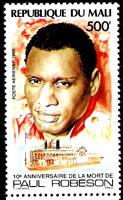
|
Colloquially, the Mississippi is often called the "Old Man River", made immortal mainly
by the song "Ol' Man River" from the musical "Show Boat" (1927).
Its music was composed by Jerome Kern, the lyrics written by Oscar Hammerstein.
A movie was made in 1936. In it Paul Robeson (stamp at left) sang the best known version
of this aria on the "Old Man River".
|
In 1865 about 4 million slaves worked in the southern states along the Mississippi river,
mostly in crops such as tobacco, cotton and sugar cane.
Harriet Beecher Stowe was an American writer and opponent of slavery. She wrote the book
"Uncle Toms Cabin", which was published in 1852 and described the miserable fate of
the enslaved black Africans.
|
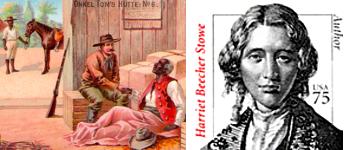
|
The book became an important polemic in the civil war of northern against southern states (1861 - 1865)
Abraham Lincoln, who had received Harriet Beecher-Stowe during the civil war in 1862,
reportedly said: "So this is the little lady who started this big war".
|
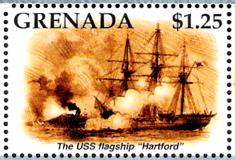
|
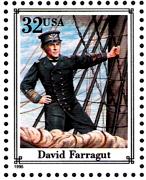
|
The American Secession War or Civil War also left its bloody marks along the Mississippi.
David Farragut was a southerner, however took completely to the side of the Northern
States Union (stamp on the right).
He commanded a small fleet , its mission was to
conquer New Orleans. His flagship was the "Hartford" (on the stamp on the left).
On the 24. of April 1862 he succeeded to break through, passing several forts and
reached New Orleans. The city was taken on the 28th of April and surrendered to
the northern states.
Farragut's most praised deed was however his victory in the battle at Mobile.
|
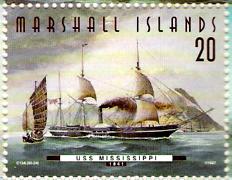
|
There were and still are many ships given the name "Mississippi". Here, a side wheel
steamer is pictured, who also took part in 1862 in the conquest of New Orleans.
During the battle the Mississippi fired two broadsides to the "Manassas" which
left her totally wrecked. The following year, however, because of her great draft she
ran aground at Port Hudson and was shot up by the Confederates.
She caught fire, and blew up.
Some data: L * W * T - 70 * 12 * 5.8 m, speed 8kn, DWT 3272, 10 guns, built from
1839 to 1841 in Philadelphia. This ship was the first U.S. Navy ship named "Mississippi".
|
The side wheel steamer "JM White" was built in 1878. The vessel was designed in the
glamerous style, which has been nicknamed "Steamboat Gothic".
She was one of the most expensive, most luxurious and largest ships on the Mississippi
River. She also marks the end of the golden age of steamboats.
Some data: L * W * T - 98 * 28 * 1.9 m, 2800 hp engine, loading bay for 10,000
bales of cotton, cabins for 250 First Class passengers.
Other sources speak of 300 cabins and 500 deck passengers and 90 people support staff.
In 1886 the ship was destroyed by fire.
|
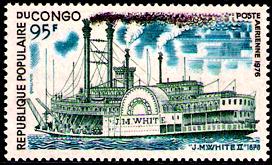
|
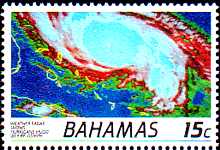
|
The southern region of Mississippi is frequently hit by tropical cyclones and severely
damaged.
Hurricane Betsy (1965) and Hurricane Katrina (2005) moved across the Mississippi Delta
towards New Orleans and continued upstream all the way to Baton Rouge.
They caused more than a billion of dollars in damage and killed about 2000 people.
|
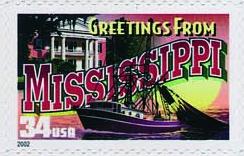
|
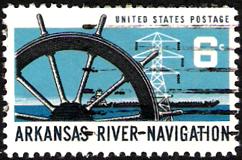
|
Today the Mississippi River is a busy waterway, a trade route on which huge amounts
of cargo are shipped right through the heart of North America.
Even super tankers can easily go up river several hundreds of miles.
The Americans have built a large "Inland Waterway" system following the
Mississippi River, and spreading out widely on both sides of it.
Aside from the Missouri and Ohio, the "Arkansas River Navigation"(stamp at the top)
is practically also part of it, because the Arkansas River is a tributary of
the Mississippi.
|
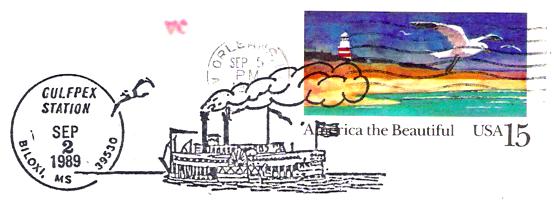
|
Sources:
Wikipedia Internet Encyclopedia
|
|